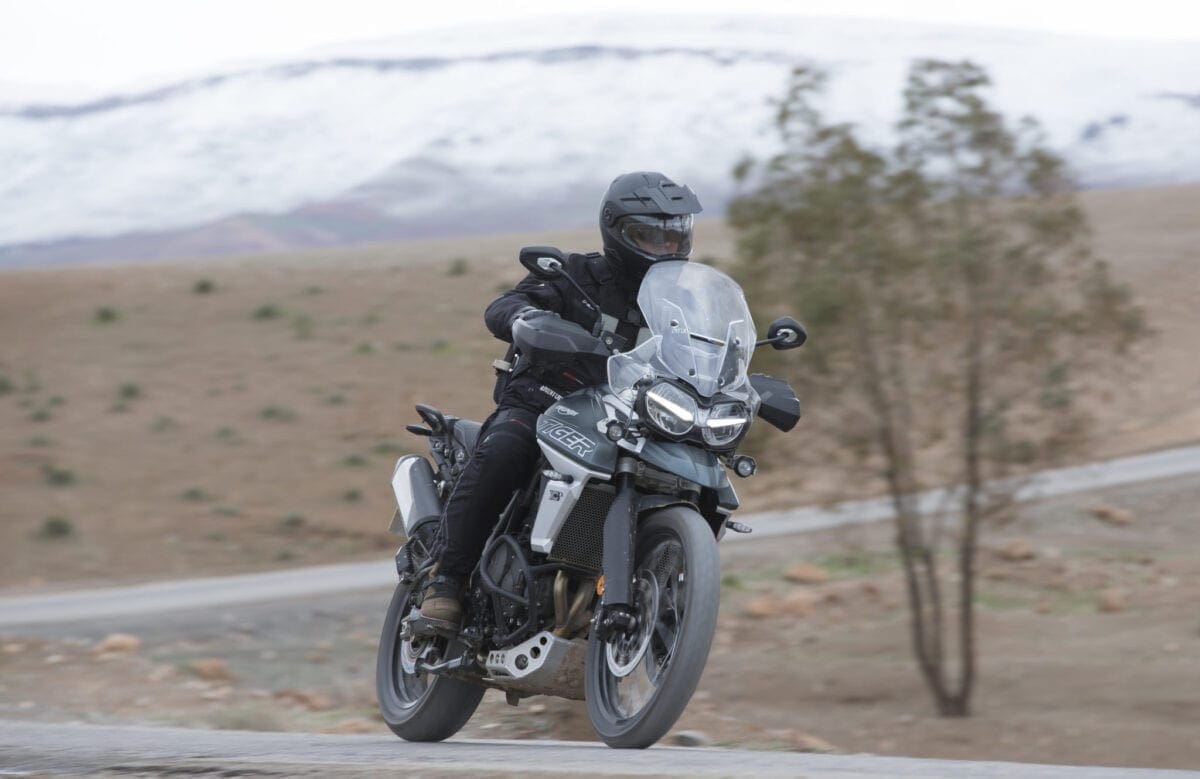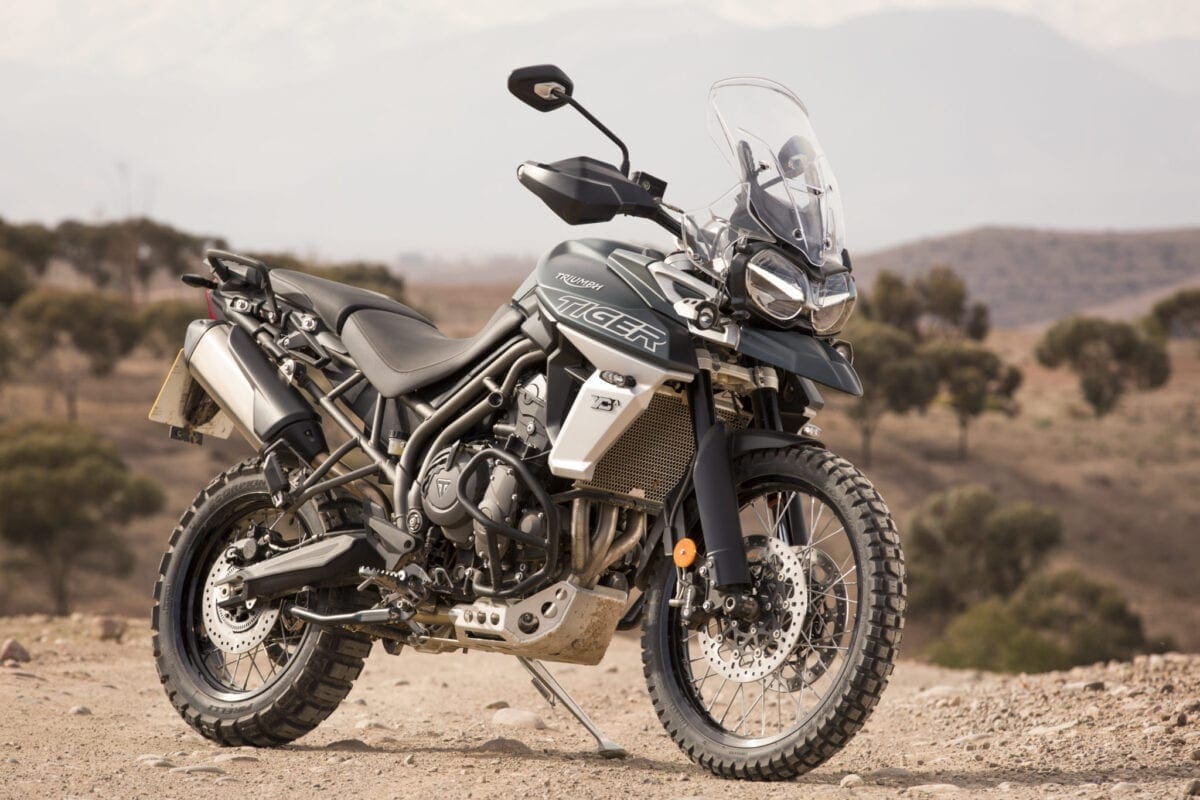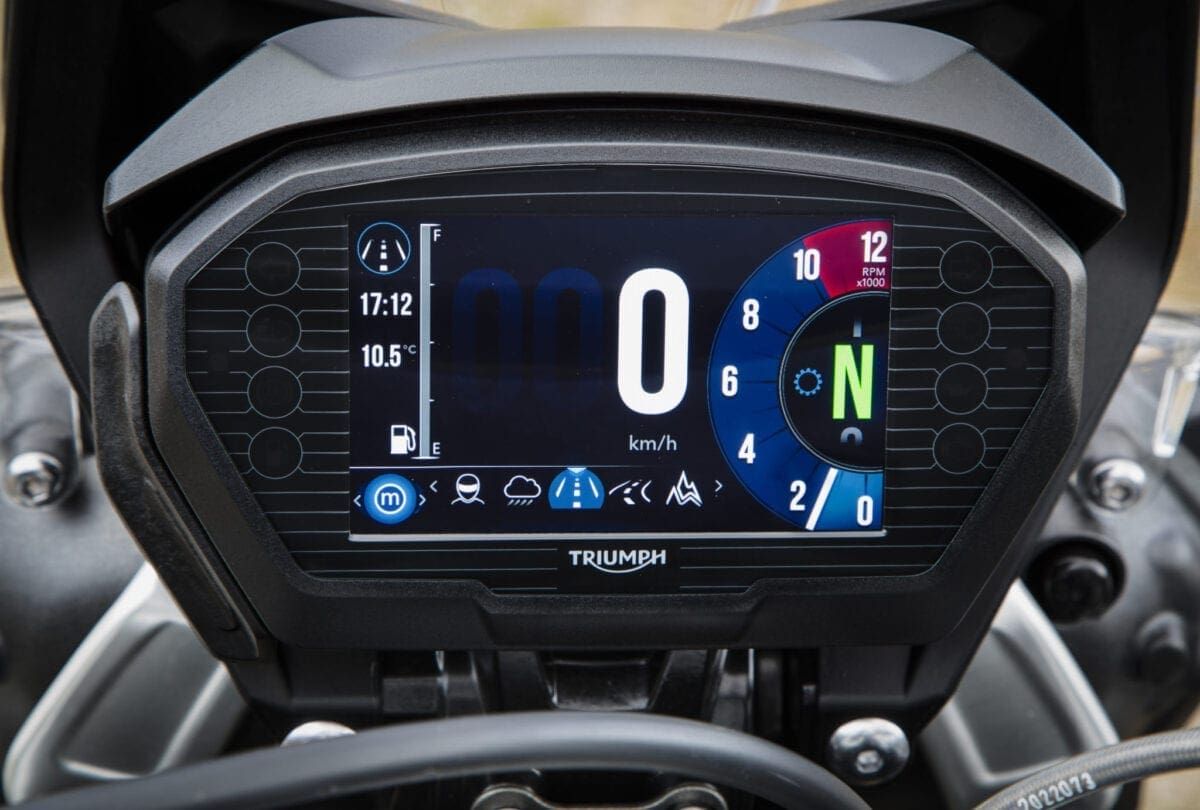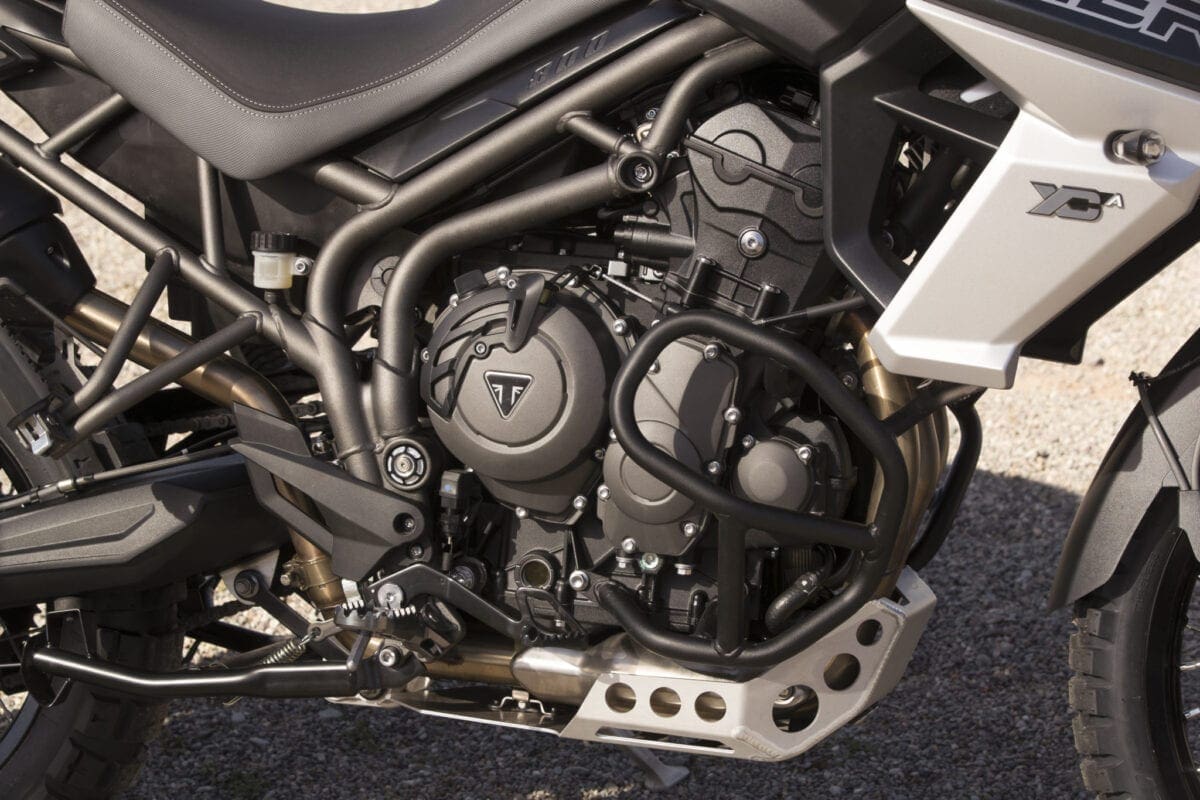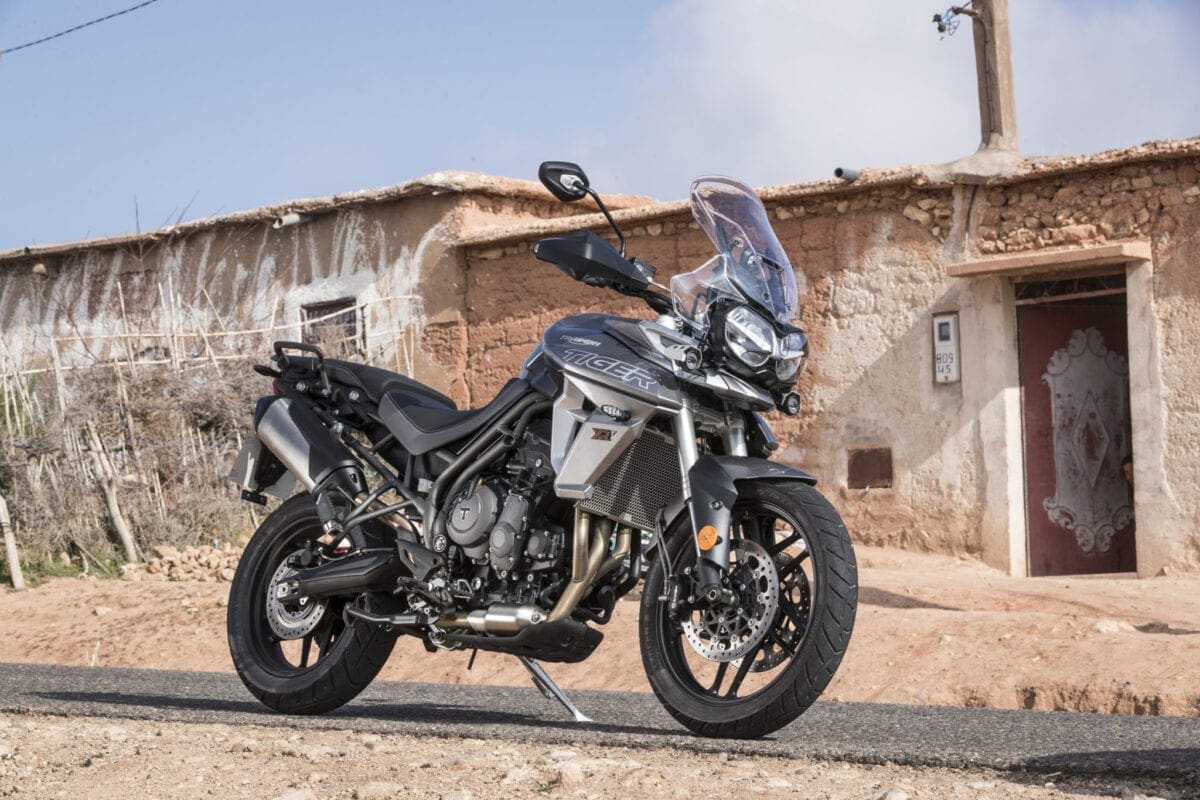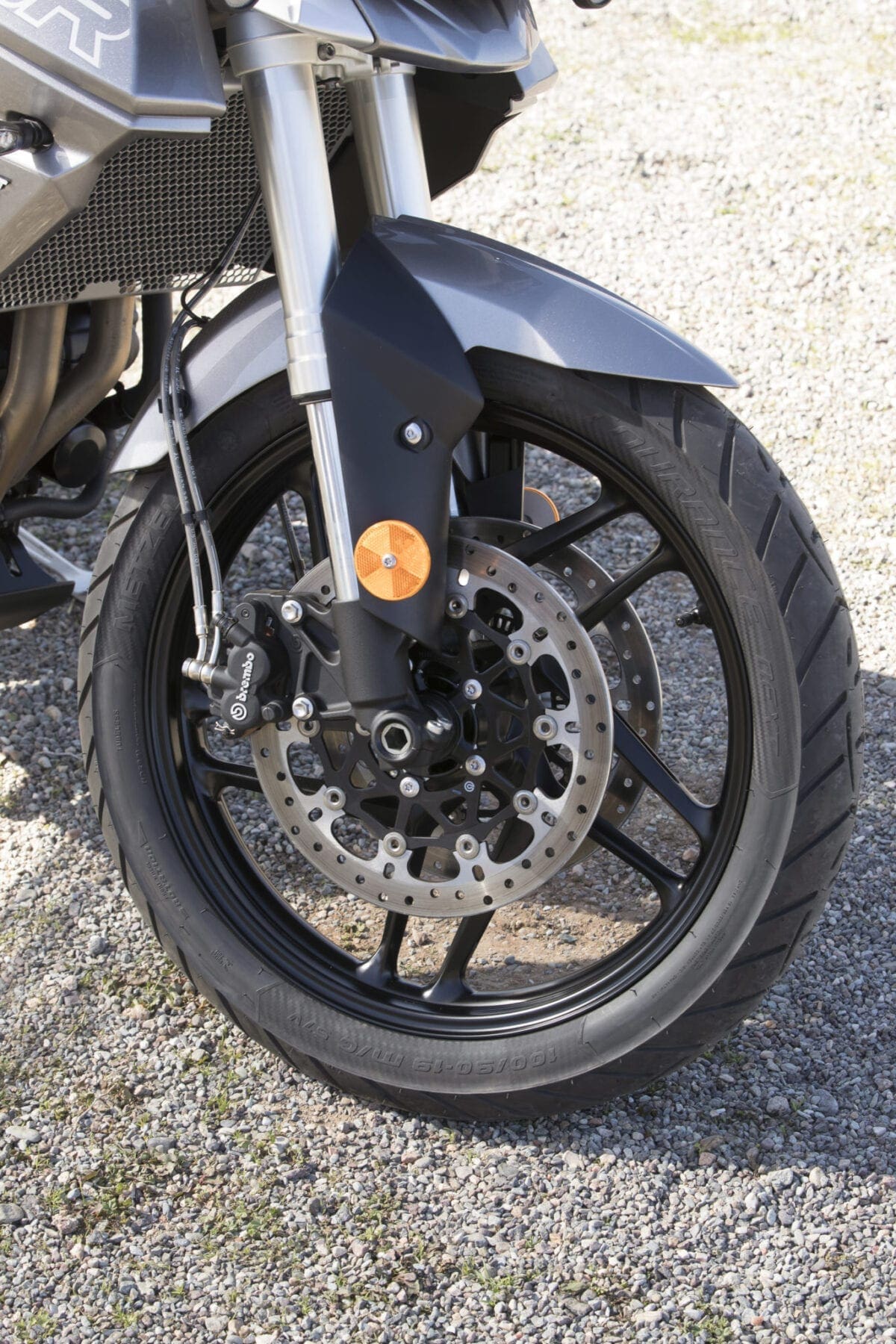Triumph’s latest Tiger 800s claim to be better in every way, on and off-road. We headed out to Morocco to see if that’s true.
If you thought the UK road network was bad, take a little ride in Morocco where tarmac quite often only covers half the width of the road, with lorries and buses regularly forcing you into the dirt.
In places there seems to be more potholes than sealed surfaces, and sometimes the roads just morph into red clay tracks for miles. Throw in a good number of stray dogs, grazing donkeys and camels, as well as curious kids trying to high-five you as you ride past, and you have a fairly standard Moroccan riding environment. It’s not the easiest place to ride, but it’s great fun – and the variety of conditions makes it the perfect location for testing adventure motorcycles.
Which is why Triumph brought us to Morocco to test the new Tiger 800s. We had a go on two models from the five-strong Tiger family: the XRT, which is the top of the range road-oriented model, and the top-spec machine from the offroad side of the pack, the XCA.
The main differences between the XRT and XCA are the wheels (cast alloy for the XR models with a 19in front rim, spoked for the XCs and a 21in front), suspension (Showa systems for the XRs, WP for the XCs), footpegs (standard for the XRs, offroad for the XCs) and styling, with the XCs gaining an adventure beak at the front.
One day, two bikes, four seasons
Riding on the edge of the Sahara desert, you’d expect a fairly stable dry climate, but as we wound our way up and down the narrow roads ribboned round the Atlas mountains, the weather went from sunny to rainy, then sleet, and finally snow. Not ideal for a leisurely ride, but perfect for getting to know the Tiger 800 quickly.
I started the day on the spoke-wheeled XCA, and right from the start I felt at home in the 840-860mm high adjustable seat. As soon as you settle on the bike, you feel the long suspension travel (220mm at the front, 215mm at the rear) welcome you with a soft bow. The bars are now 10mm closer to the pilot, making the riding position a fraction more relaxed, and the new screen is five-stage adjustable and easy to use even on the move – just pull it up and push down.
There are also new deflectors to the sides of the screen, keeping the wind and rain off your body (which was very handy later in the day). The heated comfort seat adds a bit of luxury to the XCA spec and, combined with the heated grips, kept us going through the cold and rain.
On the bike your eyes are immediately drawn to the 5in TFT screen, with either white or black background options and different layouts to choose from. The screen isn’t entirely glare-free, but you can tilt it to minimise reflections.
Switches on the XCA are backlit, although this is not usually necessary as the switches are very well positioned and easy to operate. The five-way joystick helps navigate the screens with ease, and the extensive range of bike and display settings can be explored easily.
On the dirt tracks and scrappy tarmac where we started our ride, the first impression of the bike was how well-balanced it feels. The dry weight of the XCA, the heaviest of the Tigers, is 208kg, so if you add petrol, oil and whatever other liquids are missing from this figure, you will get pretty close to the weight of other bikes in this category, such as the Honda Africa Twin. The weight is carried well on the Tiger, and slow riding is surprisingly easy, despite the sharp bite of the back brake taking a while for my brain and foot to get used to.
As the roads improved on our route and the speeds increased, the XCA continued to impress with its effortless handling and unshakable stability. Even with the larger 21in front wheel the bike seemed happy to turn pretty quickly and responded well to any body movement or steering input.
The 800cc triple engine suits the bike well, offering decent performance across the rev range, with the peak power of 94bhp arriving at 9500 revs. There are no radical changes to the engine – the main components remain the same as before – but the primary drive is new and the exhaust has been made lighter and more free-flowing to help reduce inertia. The first gear is also shorter than before to make setting off easier for less experienced riders and to add to the offroad ability of the bike.
The way that power is delivered depends on which ride mode you select. They all offer full power, but delivered in different degrees of urgency. The ride modes also have their own ABS and traction settings, and there’s a separate Rider mode where you can select your own combination of different levels of power, traction and ABS intervention.
After lunch I swapped the XCA for the road-loving XRT. I was expecting this to feel like a more of a roadster, better suited to life on tarmac, but somehow it didn’t impress me as much as the XCA. This was partially because I so enjoyed the tall and proud stance of the XCA, and the Showa system’s lesser travel (180mm/190mm), the lower seat height (810-830mm) and the smaller rubber-covered foot pegs all felt a little lacking after the larger dimensions of the XCA. The smaller front wheel also felt less dominant, and the riding position less commanding.
If you rode the XRT on its own, with no XC model to compare it to, it would no doubt feel like a perfectly good motorcycle (and indeed it is one), but ridden back to back, it was – ironically – the offroad-biased bike that I preferred on tarmac.
Playing with mud
Day two of testing was entirely offroad, and only on the XCA model designed for such terrain. To make sure we had half a chance against the rain-soaked clay, the bikes were fitted with Pirelli Scorpion Rally road-legal knobblies, suspension cranked up, and off we went. This was a chance to see if Triumph’s claims of improved offroad capability were founded.
Off the tarmac the Tiger continued to feel surprisingly well balanced and agile – for a big bike, it moved with great ease and accuracy. The only limitation was climbing up steep muddy hills, where the combination of the bike’s weight, traction control intervention in Offroad mode and the tyre profile struggled with the wet clay. For those sections the Offroad Pro mode with no traction control at all proved a big help.
On drier sections the Tiger leapt over bumps like an excitable kitten and landed back on its paws with feline grace – it was much more fun to thrash around the endless Moroccan deserts than a bike of its size and weight has any right to be.
Tigers in the wild
The bikes we tested were the top-spec models of the XR and XC ranges. You also have the choice of the base-level XR, and mid-spec XRX and XCX. There’s even a low seat version of the XRX, and you can get an A2 kit fitted by the dealer, and then removed when you pass your test.
At £9100 for the XR, there’s a big price difference between the models, but there’s also a significant difference in the level of equipment. The biggest temptation to go for the pricier models comes in the shape of their heated seats and grips, additional riding modes and higher spec brakes and suspension – these are features that really add to your riding experience.
The Tiger 800s will face fierce competition from other manufacturers with the new Honda Africa Twin Adventure Sports model leading the charge, and the new BMW F750GS and F850GS close behind. It’s a nail-biting time for manufacturers to see who comes out on top of the sales charts. Whatever the outcome, it’s great to see such a variety of great bikes arriving at dealerships this spring.
Specification – Triumph Tiger 800 XRT [XCA]
Price: £12,050 [£12,450]
Engine: 800cc liquid-cooled inline 3, DOHC
Power: 94bhp (70kW) @ 9500rpm
Torque: 58lb-ft (79Nm) @ 8050rpm
Transmission: 6-speed, chain final drive
Frame: Tubular steel trellis frame
Wheels: (F) 19in cast alloy [21in spoked]; (R) 17in cast alloy [17in spoked]
Suspension: (F) 43mm Showa USD, 180mm travel [43mm WP USD, 220mm travel]; (R) Showa monoshock, 170mm travel [WP monoshock, 215mm travel]
Brakes: (F) 305mm floating discs, Brembo 2-piston sliding calipers; (R) 255mm disc, Nissin piston sliding caliper. Switchable ABS
Seat height: 810-830mm [840-860]
Fuel capacity: 19 litres
Dry weight: 202kg [208kg]
Available from: End of February 2018
Contact: www.triumphmotorcycles.co.uk
WORDS: Mikko Nieminen, Editor, Motorcycle Sport & Leisure
PHOTOGRAPHY: Kingdom Creative

